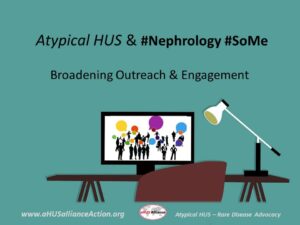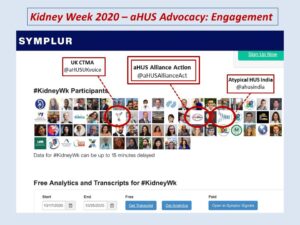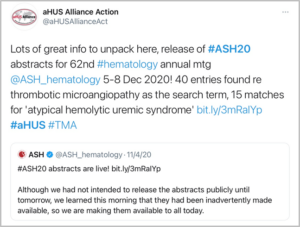Article No 393
15 November 2020

Broadening Outreach & Engagement
Consumers are always interested in learning what’s new about products that impact their lives, so it shouldn’t be surprising that people with a rare disease like atypical HUS have a deep, vested interest in learning about new research which potentially might affect them. Atypical HUS is so very rare that few physicians have experience in treating this life-threatening disease, which most often damages the kidneys but can also cause functional decline in vital organs such as the heart, brain, and lungs due to tiny clots which can form throughout the body. Sometimes called ‘familial HUS’ due to potential for inherited family genetic predisposition, aHUS research is tagged with a variety of key words, some of which include more of a hematology or immunology focus.
If your loved one were diagnosed with aHUS, wouldn’t you try to find out all you could about new knowledge gains, current treatment advancements and data from clinical trials? Patients and aHUS caregivers are deeply interested, and they often bring new research and evidence-backed data to the attention of their medical teams. Patient organizations play a role in amplifying updates and advancements in the rare disease arena, such as with the aHUS Alliance article ‘aHUS at Kidney Week 2020’ released prior to ASN’s virtual event in October.
Kidney Week is the annual gathering of nephrology specialists to share new research and clinical updates, hosted by ASN (American Society of Nephrologists). ASN interest and impact is an inclusive ‘big tent’, with much to offer far beyond physicians bearing the designation of ‘nephrologist’. Mentoring the ‘next gen’ of renal researchers and kidney clinicians is one reason patient organizations are appreciative of ASN’s efforts. Another is ASN’s social media outreach or ‘SoMe’ activity, which moves new information and kidney insights into a much wider audience beyond the four walls of ASN conference rooms. There is a robust Twitter presence regarding the nephrology community, which allows broader engagement in #nephrology #MedEd. @Nephro_Sparks tweeted these final numbers for this year’s ASN #KidneyWk: “16,373 Tweets. 3,153 Participants. 51,389,367 Impressions.” Take a look at the Symplur statistics for ASN’s virtual Kidney Week 2020 participants on Twitter, among them you’ll see: the aHUS Alliance Action team, as well the voices of aHUS patient advocacy in the UK and India.

We often hear the terms ‘patient centric’ and ‘patient-centered healthcare’. Where’s the ‘Patient Impact’ statement at events and within publications? Rare disease patients and family caregivers are directly impacted, and while the term ‘citizen scientists’ may be in play across other industries and initiatives, rarely are aHUS patients invited to share how their experiences illustrate such broad issues as delayed diagnosis, multi-organ complications, or access to treatment. We appreciate the opportunity to collaborate with researchers and clinicians to include such topics and insights from the ‘Patients’ Perspective’ in publications about our rare disease. (Raina et al, 2019)
Why is the aHUS Alliance global action team so interested each year in what goes on at ASN? Simple – it’s the information. We’re provided a ‘heads-up’ regarding new advances and insights into kidney transplants, as well as interim data on atypical HUS clinical trials and promising drug candidates. We’re able to gain a sense of the complexity regarding treatment and management of our rare disease when ASN has posters or abstracts relating to an aHUS case study that notes multi-organ involvement. We can connect terminology used by our medical care teams such as ‘complement’ and ‘thrombotic microangiopathy’ to an expanded field of new knowledge on those topics presented at ASN. We’re better able to become active participants in discussing treatment plans and disease management, since ASN has potential to help provide informational pathways which can help all stakeholders to connect the aHUS patient journey to signposts marking avenues of new aHUS information.
Notice that several of the last sentences began with “we”? That’s because patient organizations are consumers of the information flow from medical organizations and journals (eg IPNA, ISN & others) as well as from academics and industry across multiple, relevant disciplines. Patients and caregivers are not only end-users of therapeutic drugs and medical treatments, we also share aHUS research with our medical teams as active participants in determining care plans. This is especially true for rare renal diseases and the advocacy groups which serve those patients and their families. No family practice nor hospital is able to provide a neat packet of patient information materials for any of the several thousand rare diseases, most of which are genetic.**
Here are a four points worth pondering:
If at the heart of patient-centered care is an informed and engaged patient (or caregiver of a pediatric patient), how early & often are organizations and industry integrating meaningful patient experiences for initiatives, conferences, clinical trials, surveys, ‘MedEd’ and the creation of patient materials?
Instead of being confined to sharing our personal stories without context, what opportunities exist for people or advocacy groups to outline broad issues that include patient research priorities? Atypical HUS is a disease that varies widely in its symptoms, severity, and duration of aHUS activity – yet it’s seldom that clinical subtypes are gathered. A long-term dialysis patient awaiting transplant may have a different perspective than an aHUS patient experiencing cardiac or GI tract issues. It’s time to change “Patient Engagement” to a “Patient Inclusion” model, and recognize value exists beyond the ‘Patient Ambassador’ role.
Consideration should be given to inclusion of a ‘Patient Impact Statement’ within content and initiatives regarding patients and their care, to include publications, conferences, patient programs, and clinical trials. It may portray a negative aspect (Nursing Times, 2019), but often patient experiences can give unparalleled insight into what daily life is like (TMA Boston, aHUS Alliance: TMA Multi-Disciplinary Team Approach)
According to the 2016 aHUS Alliance poll (N=233, from 23 nations), 37% of respondents find and share atypical HUS research publications which were brought to their attention by aHUS patient groups. Who’s addressing this communications niche, and where is there room for rare disease patients in the communications flow of new research and knowledge? (Is there even acknowledgement that rare renal patients have both personal drive and reasons to regularly deep drive into medical publications, and launch clinician/patient discussions?)

People living with atypical HUS are often seen by hematologists, which is why the aHUS Alliance is keenly interested in the upcoming virtual meeting of the American Society of Hematology 5-8 December 2020, hashtag #ASH20. The aHUS Alliance global action team is also interested in several #ASH20 abstracts, as noted in the @aHUSallianceAct 4 Nov 2020 Tweet,, with 15 matches for the search term ‘atypical Hemolytic Uremic Syndrome’ and 40 related to thrombotic microangiopathy.

**Since definitions of what comprises a rare disease varies around the world, statistics on rare disease populations vary as well. Here’s what the World Health Organization stated in their background paper on Rare Diseases (WHO, 2013), which should indicate why rare kidney disease advocates are so very interested in the information stream offered by ASN.
“A disease is considered rare when it affects one person out of 2 000 or less. They are between 5 000 and 8 000 rare diseases, most of them genetic. A very rough estimate would be that in the world, one person out of 15 could be affected by a rare disease, this represents 400 million people worldwide of which 30 million Europeans and 25 million Americans. Rare diseases are serious chronic diseases, and are often life-threatening.”
Regarding the rare disease aHUS
No one is quite sure how many atypical HUS patients there are, perhaps an estimated 2 patients per million in the USA (Maga et al, 2010). We’re mulling over new information and various aspects which might impact how actual aHUS patient numbers might be counted. Pregnancy-associated aHUS? Prevalence vs Incidence? Complement-mediated thrombotic microangiopathy (CM-TMA, CM-aHUS)?
Terminology and descriptions of atypical HUS vary quite widely. Atypical HUS often causes patients to have low red blood cell and platelet counts along with a decrease in kidney function, as complement system becomes activated but unchecked. This damage in the small blood vessels and formation of tiny clots not only can impact the function of the kidneys but other vital organs as well. No wonder the aHUS Alliance, composed of advocates and patient groups in over 30 nations, was interested in which might at first glance seem to be diverse information presented at ASN and at ASH.
Thanks to all who harness the power of social media to improve patient outcomes!

L Burke (Nov 2020)

